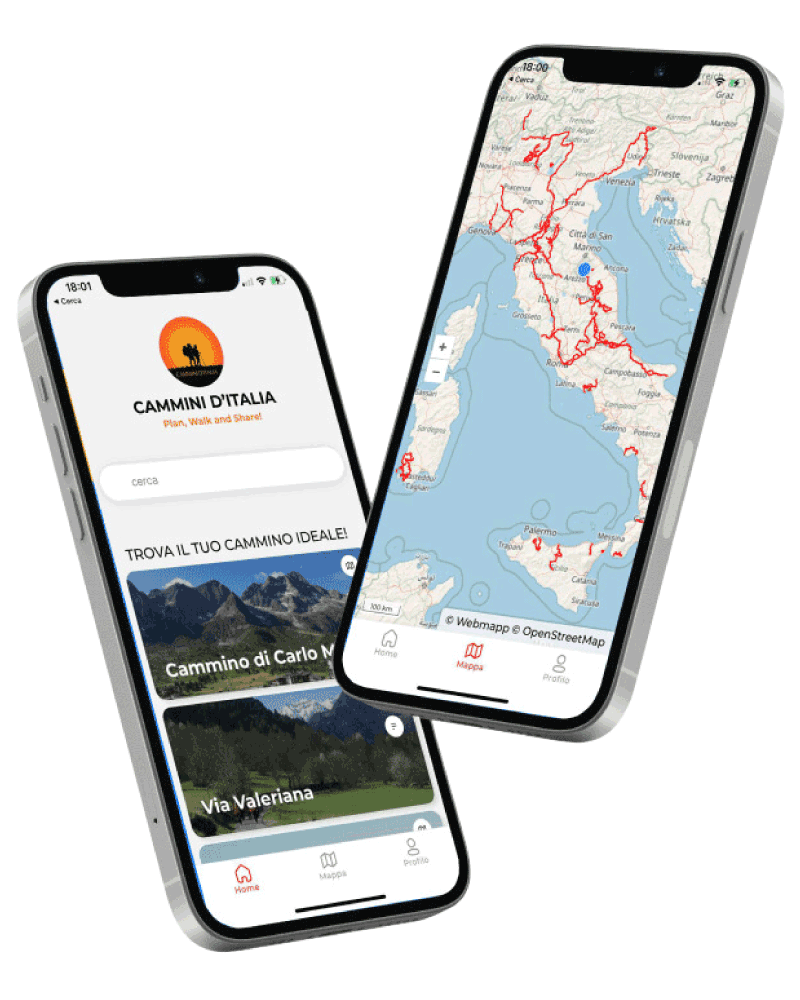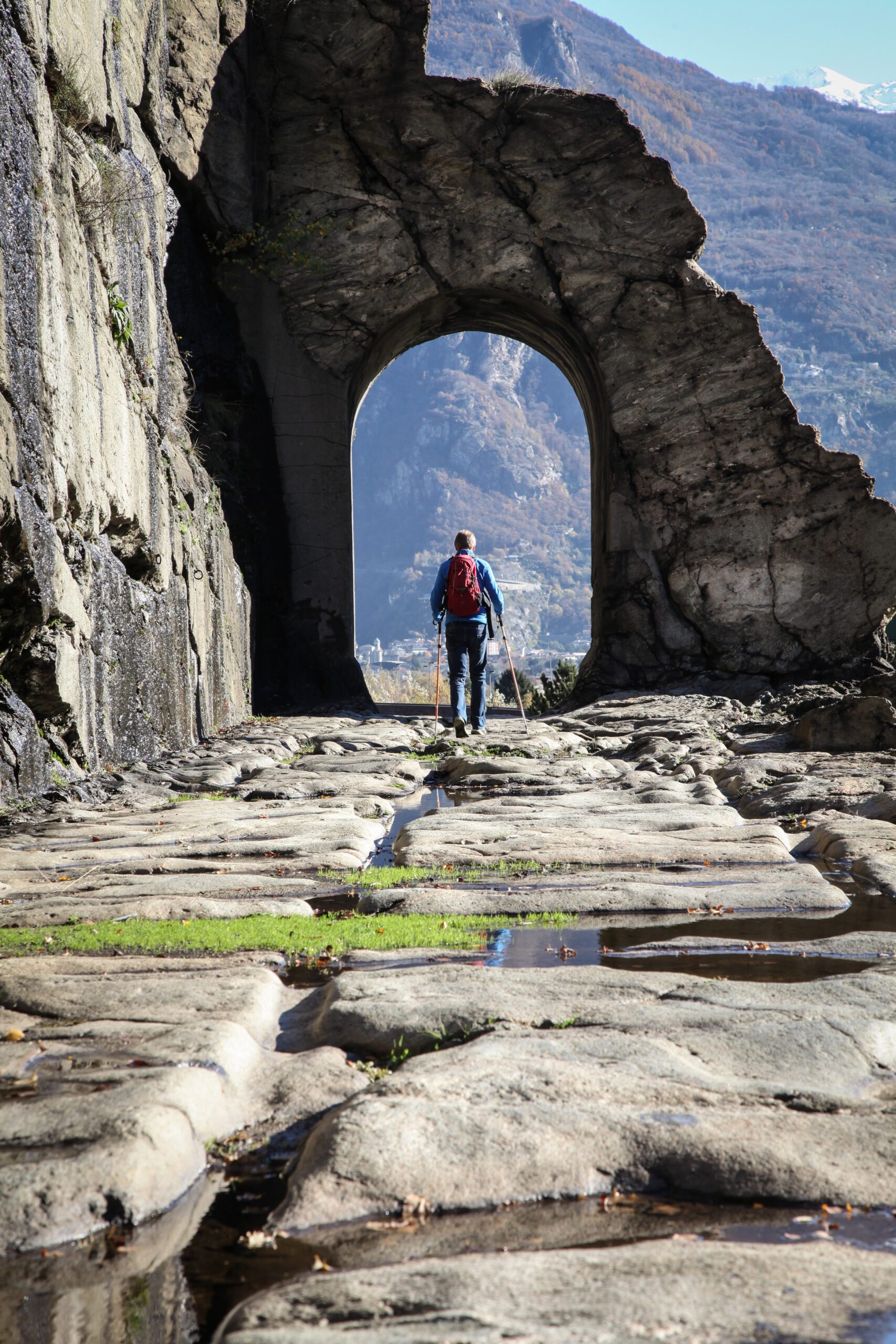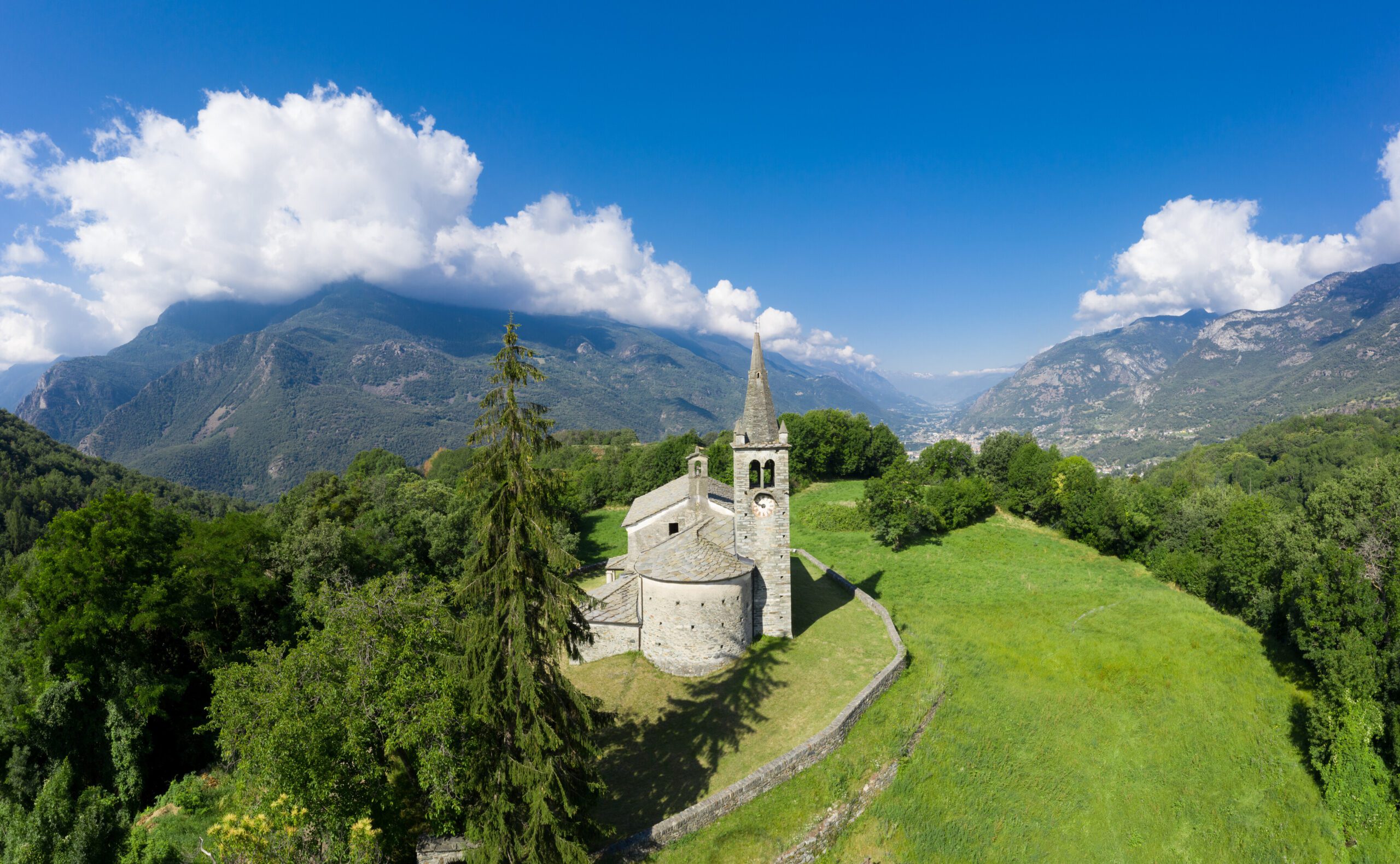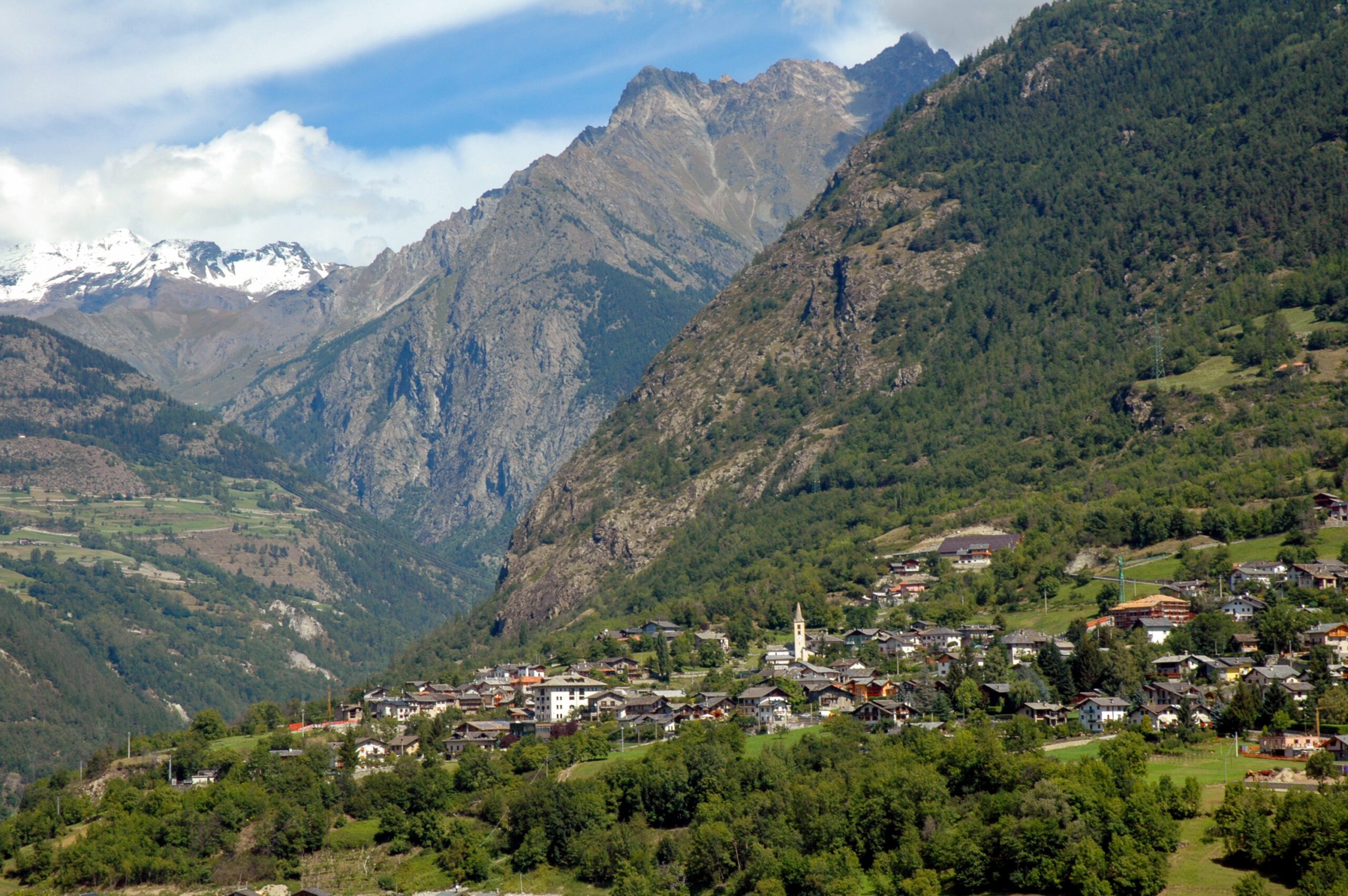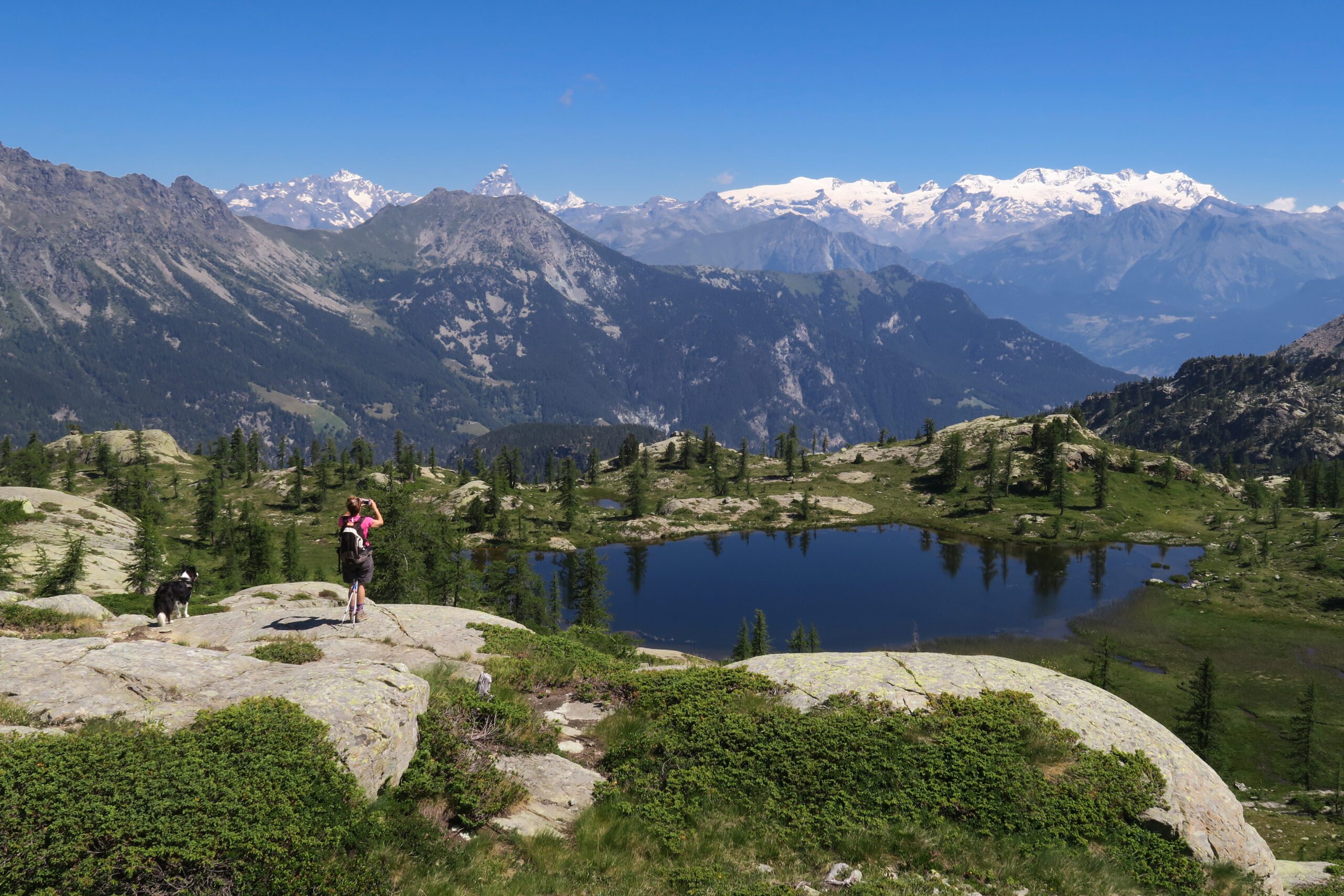
Cammino Balteo
The Cammino Balteo,route to loop in the discovery of the Aosta Valley. An immersion into culture and history through an area dotted with ancient villages and imposing castles, set in a varied landscape that alternates between forests and pastures and vegetable gardens and vineyards.
The Cammino Balteo is a loop hiking route of almost 350 km, which can be traveled in both directions. It is a journey into culture and history through an area dotted with ancient villages and imposing castles, immersed in a varied landscape that alternates forests and pastures with vegetable gardens and vineyards.
The trail is mainly on the valley floor and mid-altitude slopes with an altitude of 350 to 1900 meters above sea level, thus practicable for most of the year.
The Camino is divided into 23 STAGES of about 4-6 hours each that can also be walked in several stages or, if necessary, interrupted using public transportation. Each STAGE is an invitation to discovery, moving on foot along paths but also on dirt roads and paved sections, through villages and sites of cultural and natural interest. A proposal for everyone, suitable for sportsmen and women but also for those who want to walk unhurriedly, allowing themselves to be tempted by the many opportunities that invite pause.
Scheda Tecnica
-
Lunghezza:
350 km -
Tappe:
23 -
Partenza:
Da qualsiasi località del cammino -
Arrivo:
Da qualsiasi località del cammino -
Tema:
montano
HISTORY
From prehistory to Roman times, from the Middle Ages to the nineteenth century, Cammino Balteo unites important relics of the past into a single narrative: Roman monuments, fairy-tale castles and imposing fortresses, picturesque rural villages, ancient bridges and places of worship.
There are several places of cultural interest that can be admired or visited along the way.
(Castles and towers, villages and rural architecture, Ancient Rome along the Cammino Balteo, churches and museums)
WATER SOURCES.
In all population centers, even just small hamlets, there is at least one drinking fountain
STAGE
STAGE 1 – Pont-Saint-Martin / Lillianes
Length: 8,177
Ascent: +973
Descent: -656
Round trip: 4h oo
Return: 3h 35
The Cammino Balteo starts here, from Pont-Saint-Martin. A locality that owes its name first and foremost to the magnificent Roman bridge from the 1st century B.C. and to the legend of St. Martin of Tours, who is said to have defeated the devil to build this very bridge. Perloz, a cluster of houses boldly clinging to the rocky slope, dominated by noble houseforts under the protection of the shrine of Notre-Dame-de-La-Garde.
Passing the Lys, one continues on a midslope balcony that leads to Lillianes, greeted by the striking stone bridge built in 1733, the only one with four arches in the Aosta Valley, and by the beautiful parish church of San Rocco. A first “taste” of the Gressoney Valley.
STAGE 2 – Lillianes / Fontainemore
Length: 16,661
Ascent: +1.133
Descent: -1,098
Round trip: 6h 40
Return: 6h 25
From the center of Lillianes the trail gains altitude fairly steeply toward the Sassa mountain pasture. Then the route points northward gradually descending from the high plateaus to the rural villages. Once past the sunny Coumarial shelf, gateway to the Mont Mars Nature Reserve, small nuclei of dwellings are reached. You pass near the mid-mountain ecomuseum and you pass through the beautiful village of Farettaz.
Surrounded by forests and crossed by the Lys, Fontainemore welcomes visitors with its scenic medieval bridge and the lovely church of St. Anthony Abbot. Among the curiosities, worth a visit are the Gouffres de Guillemore, a very deep gorge carved between rocks.
STAGE 3 – Fontainemore / Donnas
Length: 14,641
Ascent: +400
Descent: – 918
Round trip: 4h 50
Return: 5h 15
From Fontainemore, through wide and beautiful mule tracks on the orographic right, you reach beautiful villages including, in particular, that of Chemp. An unusual and impressive open-air museum. From Chemp we resume the descent, through the hamlet Marine, toward Perloz. After a stop at the shrine of Notre Dame de La Garde, you return to the valley floor along the sunny slope overlooking Donnas touching the upper edge of terraced vineyards symbolic of Alpine heroic viticulture. You then reach the historic medieval village of Donnas, born on the ancient route of the Roman road of the Gauls which sees here its best known and most spectacular feature. Two small museums testify to the local rural tradition of Donnas: the “vine and wine museum” and the old “dairy of Tréby.”
STAGE 4 – Donnas / Arnad
Length: 12,490
Ascent: +1.101
Descent: -1070
Round trip: 5h 20
Return: 5h 00
From the village of Donnas you ascend the rock ridge in the direction of the village of Albard. From here you continue to climb toward the sunny grassy plateaus of Col de La Cou where you will be able to see the remains of fortifications wanted by Napoleon during his maneuvers to attack and encircle the Fortress of Bard. Passing the war posts of Arbénaz, one reaches the Machaby fort, now converted into a modern hostel. From here we then arrive at the well-known Shrine named after Our Lady of the Snow, surrounded by chestnut groves. It then continues downhill until it comes in sight of the village of Arnad and the pinkish mole of the Vallaise castle (now under restoration). Worth visiting is the charming historic center, embellished by the splendid Romanesque parish church of St. Martin.
STAGE 5 – Arnad / Challand-Saint-Victor
Length: 12,789
Ascent: +1,144
Descent: -890
Round trip: 5h 2o
Return: 5h 05
Mountain roses, gorse and alders accompany the climb from Ville di Arnad, just upstream from Vallaise Castle, toward Col Vert via this historic mule track almost forgotten. The gradual ascent leads to the discovery of beautiful chestnut forests and minute clusters of abandoned houses, however splendid examples of rural architecture And of a past peasant life. Zigzagging through patches of rhododendron, one descends toward Challand-Saint-Victor arriving near the spectacular Isollaz waterfall from which you then ascend back to the village.
STAGE 6 – Challand-Saint-Victor / Saint-Vincent
Length: 15,821
Ascent: +873
Descent: -1.125
Round trip: 5h 15
Return: 5h 25
You reach the old dairy farm of Challand-Saint-Victor, to take the path that climbs to the remains of the castle of Villa, cradle of the powerful Challant family. Past the cultural site, we continue on to the Villa Lake Nature Reserve, characterized by a special wet environment and with an easy guided trail. From here you take a slight elevation gain to the Col d’Arlaz where the gaze opens to a wide and airy panorama. You then descend, following the ru d’Arlaz, up to Emarèse. Among forests and meadow expanses, we descend gently to Moron of Saint-Vincent, welcomed by the precious Romanesque church of Saint Maurice. From here we continue the descent to Saint-Vincent passing not far from the old early 20th-century spa, now abandoned, and arriving at the modern building of the present spa.
STAGE 7 – Saint-Vincent / La Magdeleine
Length: 14,028
Ascent: +1370
Descent: -295
Round trip: 5h 40
Return: 4h 25
Leaving the center of Saint-Vincent, from the parish church one ascends toward the hilly area and higher hamlets. Gradually the built-up area will thin out to give way to long stretches of path in the midst of nature, among meadows, pastures, clearings and wooded areas. With a fluid and pleasant zigzag overlooking the underlying course of the Marmore stream and fulfilled by a magnificent panoramic view of the mouth of Valtournenche, you will reach La Magdeleine, quiet resort in the middle valley of the Matterhorn. Don’t miss a visit to the Eight characteristic mills still in operation.
STAGE 8 – La Magdeleine / Verrayes
Length: 19,767
Ascent: +756
Descent: -1,486
Round trip: 6h 10
Return: 6h 45
From La Magdeleine we set out, lapping the pretty pond of Lod and then on to the village of Hérin to reach the neighboring municipality of Antey-Saint-André where to visit the beautiful parish church of the Romanesque era. From here there is a view particularly striking on the Matterhorn which, with its majestic bulk, appears wedged between the valley walls. Interesting are the remains, almost miraculously attached to the rock face, of the Ru du Pain Perdu, a “heroic” aqueduct built in the 14th century to bring water to Saint-Vincent. Touching then on a series of characteristic hamlets, we reach Torgnon: here are worth a visit the church of San Martino and the charming ethnographic museum of Petit-Monde.
We then continue past dense forests from which to stretch our gaze over the valley floor and the imposing, dominant “rock” of the Matterhorn, until we reach the scenic chapels of Saint-Pantaléon and Saint-Evence a Saint-Denis. From the headland of Saint-Evence a gradual descent through airy plateaus and vast pastures will begin. It then descends, reaching Verrayes, with its parish church of St. Martin and the Arboretum “P. Vescoz”.
STAGE 9 – Verrayes /Nus
Length: 10,192
Ascent: +208
Descent: -876
Round trip: 3h 15
Return: 3h 35
From Verrayes capital, you reach the hamlet of Moulin and from there take a halfway trail that stretches, with little difference in elevation, almost in a straight line, through meadows, glades and small villages out of time, to Blavy from where you descend regaining the valley floor at Nus. From here, by public transportation, it is possible to reach the Astronomical Observatory of Saint-Barthélemy near which also stands the archaeological site of the protohistoric castelliere Of Lignan. In Nus, a walk along the central street will allow appreciation of the remains of the so-called Castle of Pilate, built by the Lords of Nus in the 12th-13th centuries, and which, according to legend, housed Pilate on his way to exile in Gaul after the condemnation of Jesus.
STAGE 10 – Nus / Roisan
Length: 18,524
Ascent: +525
Descent: -204
Round trip: 5h 10
Return: 5h 00
Leaving the historic center of Nus you reach the high hamlets from which you take the path that leads to the castle of Quart. Once you pass the manor house, whose original layout dates back to the late 11th century, you keep halfway up the hillside by taking the Ru Prévôt whose trail will lead easily to Roisan. Along the way you will be able to appreciate the extraordinary medieval bridge-aqueduct of the Grand-Arvou, in the locality of Chiou di Porossan. A masterpiece of hydraulic engineering. It then continues on to the Roisan overlooking the course of the Buthier stream and enjoying a splendid view of Aosta and the localities of the initial section of the Valpelline.
STAGE 11 – Roisan / Arpuilles (Aosta)
Length: 13,232
Ascent: +445
Descent: -319
Round trip: 3h 50
Return: 3h 35
After passing the cemetery of Roisan, you descend to the left, cross the locality of Adret to reach the Rû Prévôt in the direction of Valpelline. When you reach the bridge over the Buthier, you go up to take the Rû des Vignes and following this you reach the village of Gignod. Guarded by the sharp profile of the elegant bell tower of the parish church of St. Hilary, inside which one can appreciate valuable fifteenth-century frescoes, you reach the center of Gignod from which you ascend to gain altitude in view of the return route. The view opens up more until it embraces the mighty quadrangular silhouette of the medieval tower of the Lords of Gignod, a severe sentinel of the built-up area for those coming from the valley floor. We then take a pleasant, sunny path that, almost always on a level course, gently accompanies us to the hamlets of Excenex, first, and of Arpuilles, then, a veritable balcony overlooking Aosta.
STAGE 12 – Arpuilles (Aosta) / Vetan (Saint-Pierre)
Length: 14,069
Ascent: +1,081
Descent: -603
Round trip: 5h 10
Return: 4h 40
From the small village of Arpuilles you take the path that proceeds in the direction of Pléod, in the vast municipal territory of Sarre. In an airy setting characterized by a rough and essential nature giving panoramic views of the valley floor and surrounding peaks, we finally reach the village of Vetan: a place enveloped in a pervasive charm in a suspended atmosphere. On the way we overlook from above the extensive vineyards of Saint-Pierre and Aymavilles., having fun identifying the towers and castles that chase each other across the landscape.
STAGE 13 – Vetan (Saint-Pierre) / La Salle
Length: 18,848
Ascent: +893
Descent: -1,568
Round trip: 6h 40
Return: 7h 45
From Vetan you climb in altitude with unforgettable views leading to the small lake of Joux and to the picturesque village of Vens. From here, following ancient agricultural routes, we literally fly over the steep terrain of Avise: one appreciates, in the valley bottom, the Equilivaz narrows where in ancient times the Romans laboriously built the road passage known as the Pierre Taillée and, after some more challenging stretches, you reach the characteristic village of Charvaz with its old stone houses close to each other and the beautiful chapel with its frescoed facade. From here, finally, a sharply downhill section skirts the village of Fenêtre and leads to the hamlet of Moras, from which we continue to La Salle through the villages of Echarlod and Ecours, discovering corners of the Alpine Middle Ages and magnificent views of Mont Blanc.
STAGE 14 – La Salle / Avise
Length: 20,082
Ascent: +572
Descent: -821
Round trip: 5h 55
Return: 6h 05
From La Salle we continue slightly downhill and then almost level to discover the many characteristic villages that follow one another along the sunlit slope, between rock walls, meadows and heroic vineyards. From La Ruine alta to the Villair di Morgex to the last hamlet on the border with the commune of Pré-Saint-Didier: the Dailley. From here, we return back down to the historic center of Morgex, encountering the severe Tour de l’Archet, and the beautiful parish church of Santa Maria Assunta which encloses the baptismal font oldest in the upper Aosta Valley, dating back to the 5th century AD. From here you slightly regain altitude and, following the course of the Dora Baltea, reach the spectacular Lenteney waterfall. We then come to the lovely village of Derby with the beautiful Romanesque parish church dedicated to St. Bear, its ancient fortresses and the so-called notary palace. Leaving Derby, one reaches from above the village of Runaz from where it then descends again to cross the SS26 and gain the village of Avise, announced from afar by its castles and the beautiful church of San Brizio.
STAGE 15 – Avise / Introd
Length: 15,912
Ascent: +1,184
Descent: -1,179
Round trip: 6h 25
Return: 6h 10
From pretty Avise, you start climbing again along a pleasant path through woods and meadows that leads to Saint-Nicolas, heralded by the church visible from afar and stretching out, in a panoramic position, almost overhanging the valley floor. From here one descends again to the vineyards and sunny gorges of the Enfer of Arvier to then enter the village of Leverogne. The center of the village of Arvier is worth a detour, appreciating its church of St. Sulpicius and the Chateau La Mothe. From Leverogne we start climbing again at the time of the villages of Petit and Grand-Haury, guarded by the grim castle of Montmayeur. And so toward Les Combes, a delightful village nestled among vast plateaus summer destination beloved of Pope John Paul II and Pope Benedict XVI.
Finally, from Les Combes, a beautiful scenic walk crosses the meadows on a slight but steady descent to Introd, squeezed around its castle and the elegant church dedicated to the Conversion of St. Paul.
STAGE 16 – Introd / Villeneuve
Length: 20,101
Ascent: +588
Descent: -793
Round trip: 5h 40
Return: 5h 45
From Introd one ascends following an ancient path that gradually enters the dense forests suspended over the Dora di Rhêmes until reaching, in fact, Rhêmes-Saint-Georges, whose houses chase each other down a slope dominated by the soaring parish church. Crossing the stream, one reaches the microscopic hamlet of Cachoz to attack the descent still immersed in the forest. Surrounding the promontory of Mont Ruppet, from the hamlet of Soressamont you then enter the valley furrow of the Savara stream as far as the village of Chevrère, from which it resumes its descent to regain the valley floor at Villeneuve.
STAGE 17 – Villeneuve / Aymavilles
Length: 12,294
Ascent: +837
Descent: -1,000
Round trip: 4h 40
Return: 4h 55
After passing through the village of Villeneuve, we ascend to the charming church of Santa Maria with its baptismal font dating back to the 5th century A.D. under the gaze of the castle of Châtel Argent. After passing the hamlet of Chavonne, one reaches the hamlet of Issogne from which one starts to climb toward the hamlet of Camagne from where the view opens up both toward the valley floor and the Grand Eyvia stream furrow descending from the Cogne valley.
From here, we continue along a scenic path, also known as the “butterfly path,” which, past a waterfall, leads among special plant essences to the extraordinary Roman aqueduct-bridge of Pont d’Ael, a masterpiece of hydraulic engineering from the 1st century B.C. This is an area not only of considerable historical-archaeological interest, but also naturalistic given the presence of as many as 96 different species of butterflies.
From the pretty village of Pont d’Ael, we continue on to the village of Ozein, a true oasis of history set in dazzling nature. From here you descend in the direction of Champlan and, between forests and grassy crags, return to the valley floor at the height of Aymavilles.
STAGE 18 – Aymavilles / Aosta
Length: 12,862
Ascent: +453
Descent: -580
Round trip: 4h 10
Return: 4h 00
From the center of Aymavilles, after visiting the churches of Saint Léger and Christ the King, you begin to climb slightly upstream of the village toward the hamlet of Montbel. Literally immersed in the enveloping vineyards, you reach the border with the forest and keep for a long stretch almost flat on a half slope. Having entered the municipality of Jovençan you will be greeted by the medieval core of Pompiod and the quaint village that accompanies you to the interesting Maison des Anciens Remèdes. Still halfway up the coast, we will reach the hamlet Moulin di Gressan, where it is worth visiting the eco-museum Maison de Gargantua, named for the presence of the unmistakable morainic spur known as “Gargantua’s little finger.” Having passed the village of Gressan, we climb again along the stream to the hamlet of Château di Charvensod from where you descend again to return to the valley floor and, once you cross the Dora Baltea, reach Aosta.
STAGE 19 – Aosta-Aoste / Fénis
Length: 19,787
Ascent : +387
Descent: -382
Round trip: 4h 55
Return: 5h 30
From Aosta we move on to Charvensod crossing the Dora Baltea River at the height of Pont-Suaz. Upstream of the hamlet of Condemine, take the path directed to Pollein and you keep almost level until you reach Fénis. Walking halfway up the hillside, always on the edge of the forest, you can enjoy panoramic views of the Dora plain and the opposite slopes of the adret. From Pollein to Brissogne, up to Saint-Marcel where, by indulging in a stop and extending the STAGE, one could devote oneself to exploring its “higher altitude” territory (the mines, the green waters, the sanctuary of Plout). We finally reach Fénis where, greeted by the beautiful parish church of St. Maurice, after a visit to the MAV (the Museum of Valdostan Craftsmanship), all that remains is to devote oneself to the splendid turreted manor house of the Challant nobles.
STAGE 20 – Fénis / Châtillon
Length: 14,291
Ascent: +368
Descent: -393
Round trip: 4h 05
Return: 4h 00
From Fénis you reach the neighboring municipality of Nus heading toward the hamlet of Plantayes. From here follow the signs to the nearby villages of Perrinaz and Rovarey and then pass into the territory of the municipality of Verrayes.
We then continue on to Chambave, land of great and noble wines including, above all, the well-known Muscat. Guarded from above by the turreted bulk of the castle of Cly (in the commune of Saint-Denis), you go through the entire historic village of Chambave and then continue to the hamlet of Breil di Châtillon where, if you wish, you can devote a visit to the Gamba castle, home to the regional collections of modern and contemporary art, surrounded by a magnificent park. From here in a few minutes you can easily reach the center of Châtillon.
STAGE 21 – Châtillon / Verrès
Length: 20,945
Ascent: +648
Descent: -797
Round trip: 5h 45
Return: 6h 05
From the church of Châtillon you start immediately uphill reaching the hamlet of Conoz. From here you turn in the direction of Saint-Vincent following the route of an ancient ru (irrigation canal) that runs flat in the mountainside. From the spa town, where a visit to the Romanesque church of St. Vincent with its archaeological site., we continue to Cillian, where we can appreciate the monumental remains of a Roman-era bridge along the Via delle Gallie. It proceeds midstream between small villages, isolated houses, rocky crags and scenic overlooks of the valley floor below, in places very much like a deep gorge packed between rocks. We reach Montjovet, passing between the castles of Chenal e of Saint-Germain; a series of small ups and downs lead to the hamlet of Torille, not far from Verrès. Here you change sides and reach Issogne, heralded by the refined mansion of the Challants to which one should certainly dedicate a visit.
STAGE 22 – Verrès / Pontboset
Length: 17,188
Ascent: +745
Descent: -366
Round trip: 5h 05
Return: 4h 40
Verrès, an undiscovered country that has much to tell us. In addition to the fascinating manor of Ibleto di Challant which dominates it from above with its rough and severe appearance, in the historic center is camouflaged another real jewel: the Prevostura of Saint-Gilles. Its majestic bulk, elegant cross windows, tall clock tower and curious gargoyles cannot fail to attract attention. From Verrès, we move on to Issogne, dominated by the sober elegance of the castle of Giorgio di Challant. From Issogne we then reach Arnad, land of production of the well-known and renowned PDO lard; a village that will amaze you with its timeless atmospheres, its houseforts, the splendid Romanesque parish church dedicated to St. Martin and, finally, the refined Valleise Castle (currently undergoing restoration, thus temporarily closed to the public). Crossing the river again thanks to the scenic Echallod Bridge (18th cent.), we keep to the orographic right as far as the village of Hône. Here it is worth visiting the parish church of St. George and its early Christian archaeological excavations. From here, take a path that climbs halfway up the sunny rocky slopes overlooking the Ayasse stream to Pontboset.
STAGE 23 – Pontboset / Pont-Saint-Martin
Length: 13,365
Ascent: +538
Descent: -1,044
Round trip: 4h 10
Return: 4h 40
Leaving the small village of Pontboset with its eighteenth-century bridges and crossed the Ayasse stream, begin the descent to regain the valley floor. Little by little the panorama will offer, northward, the spectacle of Mont Mars and Monbarone. Gradually the valley will open up with the fan of the villages of Hône and Bard, dominated by its imposing Fort. Then reaching the plain of the Dora, we cross the village of Bard and you enter that of Donnas passing through the most striking stretch of the Roman road of the Gauls. After the built-up area, we ascend slightly to walk among the vineyards up to the Bousc Daré locality from which, finally, you return to Pont-Saint-Martin.
SIGNAGE
All along the route there is signage marked by an inverted triangle inside which is inserted No. 3
DANGERS
There are no dangerous parts on the way
ACCESSIBILITY
There are no sections that are passable by people with disabilities
ROAD BOTTOM.
30% asphalt
CONTACTS
Office of Tourism:
Tel: (+39) 0165.40532
E-mail: info@turismo.vda.it
Hospitality:
https://bookingvalledaosta.it/i-cammini/
https://balteus.lovevda.it/it/ospitalita
Booking Valle d’Aosta telephone reservation center at 0165 33352.
GUIDE TO CAMMINO BALTEO
A loop route slowly traversing the Aosta Valley, backpacking between the course of the Dora Baltea river and the heroic vineyards that challenge the mountain, a 23-stage path winds its way through small villages, castles and spectacular landscapes, built stone by stone by generations. This is a path where identity is strong, alive and present: from the Roman bridges to the castles of the noble Challant family, to the “patois” that is more than a dialect, it is the very soul of the Valley.
Each STAGE offers the opportunity to experience the Aosta Valley at your own pace: those who walk with their families will find suitable stages, those who love running will have a route full of challenges, and those who prefer to walk unhurriedly will be able to enjoy every glimpse of the Alps and breathe in the authenticity of this land.
The guide to Cammino Balteo provides you with everything you need to set off safely: detailed maps, elevation elevations, elevation changes, accurate route descriptions, and advice on hospitality and points of interest not to be missed. In addition, you’ll find practical tips for dividing your STAGE, using public transportation, and customizing the itinerary to suit your needs.
Immerse yourself in the Aosta Valley, discover at your own pace its traditions and breathtaking landscapes. One path, many stories to experience.
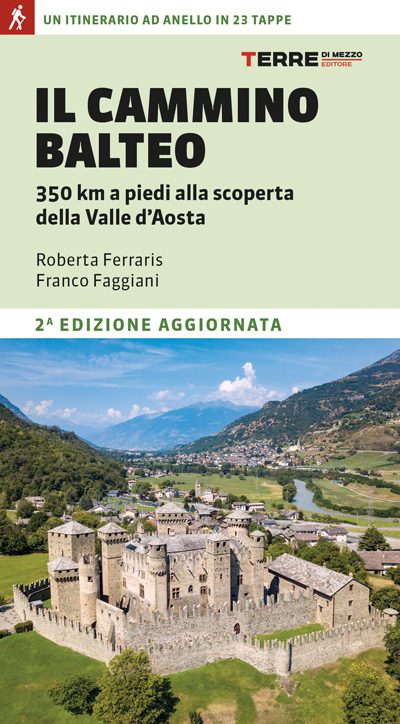
Approfondimenti
Cammino Balteo
With the free Cammini d’Italia app, you can plan and walk the Cammino Balteo safely, being able to plan the stages in detail and walk the route thanks to the built-in GPS technology that supports your orientation during your adventure.
⠀Inside the app you will find many other paths present in Italy. Thanks to the georeferenced tracks of many routes you will be able to study the itinerary that suits you best and also download the GPX tracks of the individual STAGEs offline.
The app also includes a complete digital map of all the paths surveyed to date on our portal, giving you a wide range of choices among the many paths in the Belpaese.
⠀⠀
Cammini d’Italia is the perfect app for those who want to explore the beauty of Italy on foot, discovering hidden places surrounded by nature. Download it for free today and start planning your next adventure!
⠀
⠀
